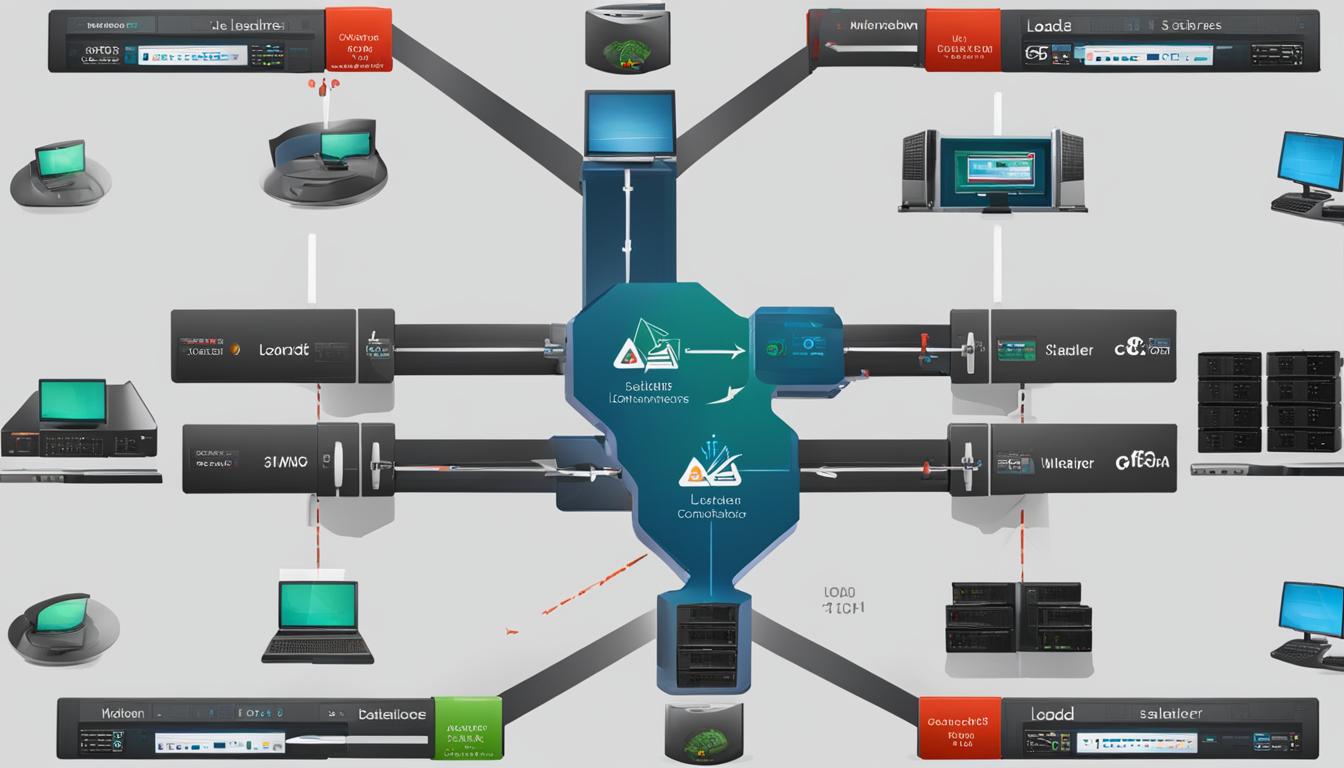Understanding What is Load Balancer Explained
As an experienced journalist in the field of networking technology, I am excited to delve into the topic of load balancing and its various implications. Load balancing refers to the efficient distribution of incoming network traffic across a group of backend servers, also known as a server farm or server pool. But what does this really mean and why is it important?
Imagine a load balancer as a “traffic cop” sitting in front of servers, routing client requests across all servers capable of fulfilling those requests. Its role is to maximize speed and capacity utilization while ensuring that no one server is overworked. By sending requests only to online servers, it ensures high availability and reliability.
Load balancing is crucial for high-traffic websites, especially those dealing with heavy loads of incoming requests. It provides benefits such as reduced downtime, scalability, redundancy, flexibility, and efficiency. With the ability to distribute client requests or network load efficiently across multiple servers, load balancing has become an integral part of modern networking.
Key Takeaways
- Load balancing efficiently distributes network traffic across a group of servers, maximizing speed and capacity utilization.
- Load balancers ensure high availability and reliability by sending client requests only to online servers.
- Load balancing algorithms, such as round robin and least connections, determine how requests are distributed.
- Load balancing provides benefits like reduced downtime, scalability, redundancy, flexibility, and efficiency.
- Load balancers can be hardware-based or software-based, offering different cost and flexibility advantages.
Load Balancing Algorithms
When it comes to load balancing, different algorithms provide different benefits. Here are several commonly used load balancing algorithms:
Round Robin
The round robin algorithm distributes client requests across servers sequentially. Each server takes turns handling incoming requests, ensuring a fair distribution of the workload.
Least Connections
The least connections algorithm directs client requests to the server with the fewest current connections to clients. This approach helps balance the load by sending new traffic to servers that are less busy.
Least Time
The least time algorithm selects the server with the fastest response time and the fewest active connections to handle client requests. By routing traffic to high-performing servers, it minimizes latency and improves overall system performance.
Hash
The hash algorithm distributes client requests based on a key defined by the client IP address or the request URL. This ensures that all requests from a specific client are sent to the same server, maintaining session persistence and consistent performance.
IP Hash
The IP hash algorithm uses the client’s IP address to determine which server should receive the request. By mapping each client to a specific server, it ensures that subsequent requests from the same client are consistently directed to that server.
Random with Two Choices
The random with two choices algorithm randomly selects two servers and applies either the least connections or least time algorithm. This approach helps balance the load and introduces an element of randomness in the server selection process.
These load balancing algorithms play a crucial role in efficiently distributing client requests across backend servers, optimizing performance, and ensuring high availability.
Benefits of Load Balancing
Load balancing provides several benefits for high-traffic websites. These benefits include:
- Reduced Downtime: Load balancing helps minimize downtime by redirecting traffic to remaining online servers when one server goes down. This ensures that users can continue accessing the website without interruption.
- Scalability: Load balancing allows for easy scalability by adding or subtracting servers as demand dictates. This flexibility ensures that the website can handle increased traffic without overloading the servers.
- Redundancy: Load balancing provides redundancy, ensuring high availability and reliability. By sending requests only to servers that are online, load balancing ensures that there is always a backup server ready to handle traffic in case of a server failure.
- Flexibility: Load balancing offers flexibility in managing server resources and handling traffic spikes. It allows administrators to allocate resources and distribute the load based on demand, ensuring optimal performance at all times.
- Efficiency: Load balancing improves efficiency by distributing client requests or network load efficiently across multiple servers. This prevents any single server from becoming overwhelmed, resulting in faster response times for users.
“Load balancing provides benefits like reduced downtime, scalability, redundancy, flexibility, and efficiency.”

Implementing load balancing is crucial for ensuring the smooth functioning of high-traffic websites. It not only improves website performance but also enhances user experience by reducing downtime and providing scalability, redundancy, flexibility, and efficiency.
Session Persistence
Session persistence, also known as sticky sessions, plays a crucial role in ensuring consistent performance and handling user sessions on high-traffic websites.
When a client interacts with a website or application, session persistence ensures that all subsequent requests from that client are sent to the same server for the duration of their session. This is particularly important for applications that store session information locally in the client’s browser.
By maintaining the connection between a client and a specific server, session persistence minimizes the need for server switches during a session. This prevents performance issues and inefficiencies that may arise when session-related data is distributed across multiple servers.
Load balancers, like the popular NGINX Plus, can handle session persistence as needed, improving the user experience and overall application performance. By intelligently routing client requests to the appropriate server, load balancers ensure that session-related data, such as shopping carts, user preferences, or ongoing transactions, remains intact.
With session persistence, clients enjoy a seamless and uninterrupted experience, while application servers can efficiently handle user sessions and deliver personalized content.
Conclusion
In conclusion, load balancing is an essential technology that efficiently distributes incoming network traffic across a group of backend servers. By acting as a “traffic cop,” load balancers maximize speed, capacity utilization, and server availability. Different load balancing algorithms, such as round robin, least connections, and hash, offer various benefits in distributing client requests.
Implementing load balancing technology brings numerous advantages, including reduced downtime, scalability, and redundancy. Load balancing ensures that requests are sent to servers that are online, improving high availability and reliability. It also offers flexibility and efficiency by efficiently managing server resources and handling traffic spikes.
Session persistence is crucial for maintaining consistent performance and handling user sessions. By keeping all client requests with the same server throughout the session, load balancers enhance the user experience and prevent performance issues. When choosing between hardware and software load balancers, considerations should be made based on specific needs and requirements.
Overall, load balancing plays a significant role in optimizing networking efficiency and improving the user experience on high-traffic websites. Its ability to efficiently distribute network load and maximize server resources makes it an indispensable technology for modern applications.
FAQ
What is a load balancer?
A load balancer refers to efficiently distributing incoming network traffic across a group of backend servers, also known as a server farm or server pool. It acts as a “traffic cop” sitting in front of servers and routing client requests across all servers capable of fulfilling those requests, maximizing speed and capacity utilization while ensuring that no one server is overworked.
How does a load balancer ensure high availability and reliability?
A load balancer ensures high availability and reliability by sending requests only to servers that are online. When a new server is added to the server group, the load balancer automatically starts sending requests to it.
What are load balancing algorithms?
Load balancing algorithms, such as round robin, least connections, least time, hash, IP hash, and random with two choices, determine how client requests are distributed across servers.
What are the benefits of load balancing?
Load balancing provides benefits like reduced downtime, scalability, redundancy, flexibility, and efficiency. It helps reduce downtime by redirecting traffic to remaining online servers when one server goes down, allows for scalability by adding or subtracting servers as demand dictates, ensures high availability and reliability, offers flexibility in managing server resources and handling traffic spikes, and improves efficiency by distributing client requests or network load efficiently.
What is session persistence?
Session persistence is important for maintaining consistent performance and handling user sessions. It ensures that all requests from a client are sent to the same server for the duration of the session, which is crucial for applications that store session information locally in the browser. Session persistence can also prevent performance issues and inefficiencies caused by server switches.
What is the difference between hardware and software load balancers?
Load balancers can be hardware-based or software-based. Hardware load balancers are physical appliances specifically designed for load balancing, while software load balancers are software applications that run on standard servers. Software-based solutions are typically less expensive and more flexible.
Why is load balancing important?
Load balancing is a crucial technology for efficiently distributing incoming network traffic across a group of backend servers. It helps maximize speed, capacity utilization, and the availability of servers. Load balancing also plays a significant role in optimizing networking efficiency and improving the user experience on high-traffic websites.
- About the Author
- Latest Posts
Janina is a technical editor at Text-Center.com and loves to write about computer technology and latest trends in information technology. She also works for Biteno.com.






